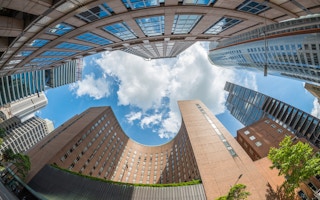Green building advocates should focus not only on raising energy efficiency and reducing emissions in the built environment, but also look to improve the well-being of occupants, as this can unlock new economic and sustainability opportunities, said experts at the Green Cities conference in Sydney last week.
To continue reading, subscribe to Eco‑Business.
There's something for everyone. We offer a range of subscription plans.
- Access our stories and receive our Insights Weekly newsletter with the free EB Member plan.
- Unlock unlimited access to our content and archive with EB Circle.
- Publish your content with EB Premium.
John Mandyck, chief sustainability officer of United States-based United Technologies Corporation (UTC), told the 600-strong audience in Sydney’s Hilton Hotel on March 22 that compared to the money spent on human resources, energy bills make up a small proportion of a building’s operating costs.
Once a building has been constructed, more than 90 per cent of the costs associated with it relate to company spending on the people who work within it rather than energy and maintenance, said Mandyck, And yet, when a firm is assessing the payback period for investing in sustainable fixtures, energy savings have been the dominant, if not only, consideration so far, he added.
The impact of features such as ample natural ventilation and lighting, and better indoor air quality on occupant health and performance has not yet been fully recognised by the industry, said Mandyck.
If the sector pays more attention to maximising the health benefits of adopting sustainable practices, buildings “can become human resource tools and competitive assets”, he added.
Citing research sponsored by UTC and conducted by researchers from Harvard University, the State University of New York (SUNY) Upstate Medical University, and Syracuse University in the United States, Mandyck said that green buildings improve the cognitive function and productivity of occupants.
Released last October, the Impact of Green Buildings on Cognitive Function study hosted 24 participants in laboratory conditions designed to simulate indoor environments in conventional buildings, green buildings, and sustainable structures with enhanced ventilation.
Variables such as the presence of volatile organic compounds - many of which are toxic to human health - and carbon dioxide concentrations were externally controlled. After working in the laboratory over a two-week period, participants did a series of tests on information usage, strategy, and crisis response.
The study found that participants working in green environments had 61 per cent higher scores than those in conventional ones. And in the laboratories with enhanced ventilation, cognitive function results were 101 per cent higher than normal ones.
The researchers also found that spending between US$14 and US$40 per person per year on improving the indoor air environment could improve each employee’s productivity by US$6,500 annually.
These findings “will change and accelerate the green building movement,” said Mandyck. They make an even stronger economic case for investing in clean technologies, he added.
One certification system which measures the impact of building features on health and well-being is the WELL Building System, administered by the United States-based non-profit International Well Building Institute (IWBI).
The WELL Standard, first launched in 2014, maps out how building features such as air quality, ventilation, and lighting among others, affect body functions such as the cardiovascular, respiratory, reproductive, and endocrine systems.
Paul Scialla, founder of IWBI, who also spoke at the conference, said that there are “massive social benefits” if the built environment can be calibrated to prevent or reduce health problems.
“The green building movement has done a great job of setting the foundation for considering the environmental impact of buildings” he said. “The WELL Standard advances that dialogue to focus on people”.
To facilitate a closer collaboration between health advocates and green building professionals, the Green Building Council of Australia (GBCA) signed a memorandum of understanding with IWBI at the conference to align GBCA’s Green Star rating system with the WELL Standard.
GBCA will work with IWBI to identify opportunities to streamline both rating systems. It will also run events and education initiatives to train industry professionals on building practices which can improve the health and well-being of occupants.
Romilly Madew, chief executive officer, GBCA, noted in a statement that more Australians are recognising the impact of buildings on their health and well-being. “This new partnership is an important step towards designing and building places that are sustainable, productive and healthy,” she said.








